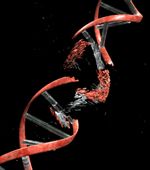Genetic Characterization of Triple-Negative Breast Cancer
Researchers at the University of British Columbia in Vancouver, Canada have sequenced and analyzed over 100 triple-negative breast tumors at the time of diagnosis, the first in-depth genomic analysis of this heterogeneous breast cancer subtype.
Sixteen percent of breast cancers are better characterized by the genetic mutations they lack. These cancers are referred to as triple-negative breast cancers (TNBCs). Rather than a unified tumor type, this classification encompasses many minor tumor subtypes. The unifying characteristic of the triple-negative subtype is aggressive disease that is often highly invasive and difficult to treat.

Researchers have sequenced and analyzed over 100 triple-negative breast tumors, the first in-depth genomic analysis of this breast cancer subtype
As a step toward better defining this heterogeneous breast cancer subtype, Samuel Aparicio, PhD of the University of British Columbia in Vancouver, Canada and colleagues sequenced and analyzed over 100 triple-negative breast tumors at the time of diagnosis. The results, published today in Nature, show a wide frequency range of somatic aberrations-some tumors have a relatively small number of coding somatic mutations, in a limited number of molecular pathways, while others contain hundreds of somatic mutations, involved in multiple pathways that are linked to disease progression.[1]
This is the first in-depth genomic analysis of primary TNBCs, according to the authors. The high heterogeneity, not completely unexpected, means that the way to characterize this tumor type is to determine the genetic variations within an individual patient’s tumor-the underlying genetic mutations may facilitate both treatment choice and the better understanding of a patient’s therapeutic response.
"The results on specific genes show very few new driver genes that we didn't know before, suggesting that there will be many TNBCs without identified ‘actionable’ drivers," says Andrea L. Richardson, MD, PhD of the Brigham And Women's Hospital and Harvard Medical School.
The Data Analysis
The researchers sequenced the genome and transcriptome of 104 primary TNBCs. To analyze tumor clonal evolution, the clonal mutation frequency was estimated from allele abundance, taking into account copy number states and loss of heterozygosity.
To confirm the findings in the general breast cancer population, the research group sequenced the exons of all 29 genes enriched in the TNBC cohort in 159 other breast cancers (estrogen [ER]-positive and ER-negative tumors).
The study identifies an intragenic deletion in PARK2, a tumor suppressor gene, linking the gene to TNBC for the first time-the mutation in the gene was found in 6% of the triple-negative breast tumors analyzed. Other relatively frequent genes affected by copy alteration events were RB1 (5%), EGFR (5%), and PTEN (3%). The authors note that a comparison of somatic mutation distribution with the proportion of the genome with copy number alterations did not yield a correlation. The same copy number alteration frequency was seen in a large-scale breast tumor genomic profiling study. Consistent with previous analyses, structural chromosomal rearrangements were not frequently observed, but a few individual fusion events in known oncogene and tumor suppressors (eg KRAS, RB1) were observed.
The most frequently mutated gene among TNBCs was p53; 62% of basal TNBC and 43% of nonbasal TNBC had a mutation in p53. Other genes frequently harboring mutations were PIK3CA (10.2%), USHA2 (Usher syndrome gene, 9.2%), MYO3A (9.2%), and PTEN and RB1 (both 7.7%). Other recurrent mutations were SYNE1 and SYNE2 (synuclein genes, 9.2%), which have been implicated, in squamous head and neck cancers, BRCA2 (4.6%), and BRAF, ERBB2, ERBB3, and NRAS (3.1%).
MYO3A, a candidate tumor-driving mutation, encodes a cytoskeletal motor protein that functions in cell shape and motility. Other mutations include genes that function in extracellular matrix interaction, integrins, and genes that regulate the actin cytoskeleton. While these processes have been implicated in cancer progression in general, this is the first time that they have been linked to TNBC specifically.
Of the TNBC cases analyzed, 12% did not have somatic mutations in any established tumor-driving gene or in cytoskeletal genes. "This suggests that primary TNBCs are mutationally heterogeneous from the outset, with some patients’ tumors having a small number of implicated pathways and few mutations, whereas other patients present with tumors containing extensive mutation burdens and multiple pathway involvement," explain the authors.
However, Richardson does not think too much emphasis should be placed on the somatic changes of the cytoskeletal genes as no clear evidence of function has been provided yet. "Any suggestion that these genes are important for tumor progression is premature," Richardson emphasizes.
Only 36% of the somatic mutations detected are actually expressed. A further validation, deep resequencing of the allelic abundance of over 2,400 somatic single nucleotide variants, including 104 genes, shows the relative clonal abundance of clonal frequencies among cases representative of the entire population.
The pathways that involve p53 and PIK3CA showed higher clonal frequencies, indicating their early "founder" mutation status and key role in early tumorigenesis. Mutations in pathways involved in the cytoskeleton and cell motility had a lower clonal frequency. This suggests that mutations in genes with extracellular matrix and cytoskeletal functions are acquired later in tumor evolution.
Next Steps
"The exome sequencing approach used has its strength, such as depth of sequence, but does not identify gene rearrangements or other patterns of mutation," says Richardson. She suggests that broader use of other techniques, such as whole genome sequencing will be complementary, and better able to identify rearrangements. "New breast cancer sequencing studies using more whole genome data are coming out soon which will provide more insight."
Reference
1. Sohrab P. Shah, Andrew Roth, Rodrigo Goya, et al. The clonal and mutational evolution spectrum of primary triple-negative breast cancers. Nature. 2012 Apr. 4. [Epub ahead of print]